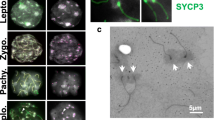Abstract
Normal human bone marrow and peripheral blood leukocytes as well as malignant cells from a variety of leukemias and lymphomas, demonstrate somatic pairing of centromeres and p arms of chromosome 15 during interphase. This phenomenon, effected by sequences on the p arm and requiring the intranuclear transport of spatial domains for at least one of the homologs, was not seen in amniotic fluid cells, uterine cervical tissue or in tissue fibroblasts. These studies contribute to the recent evidence of somatic pairing of homologous chromosomes in man and provide support for mobile chromosomal domains in interphase. It appears that sequences on the p arm of chromosome 15, possibly the nucleolar organizing genes, are uniquely important in the maturation of benign and malignant cells of hemato-lymphopoietic origin.
Similar content being viewed by others
References
Arnoldus EPJ, Peters ACB, Bots GTAM, Raap AK, Ploeg M Van der (1989) Somatic pairing of chromosome 1 centromeres in interphase nuclei of human cerebellum. Hum Genet 83:231–234
Arnoldus EPJ, Noordermeer IA, Boudewijn Peters AC, Voormolen JHC, Bots GTAM, Raap AK, Ploeg M Van der (1991) Interphase cytogenetics of brain tumors. Genes Chromosomes Cancer 3:101–107
Bauman JGJ, Bentvelzen P (1988) Flow cytometric detection of ribosomal RNA in suspended cells by fluorescent in situ hybridization. Cytometry 9:517–524
Boni U de, Mintz AH (1986) Curvilinear, three-dimensional motion of chromatin domains and nucleoli in neuronal interphase nuclei. Science 234:863–866
Borden J, Manuelidis L (1988) Movement of the X chromosome in Epilepsy. Science 242:1687–1691
Bourgeois CA, Costagliola D, Laquierriere F, Bard F, Hemon D, Bouteille M (1984) In situ arrangement of NOR-bearing chromosomes in the interphase nucleus of Aotus trivirgatus. J Cell Sci 69:107–115
Bourgeois CA, Laquerriere F, Hemon D, Hubert J, Bouteille M (1985) New data on the in situ position of the inactive X chromosome in the interphase nucleus of human fibroblasts. Hum Genet 69:122–129
Bureau J, Hubert J, Bouteille M (1986) Attachment of DNA to nucleolar and nuclear skeletal structures as visualized by Kleinschmidt molecular spreading. Biol Cell 56:7–16
Comings DE (1980) Arrangement of chromatin in the nucleus. Hum Genet 53:131–143
Cremer T, Lichter P, Borden J, Ward DC, Manuelidis L (1988) Detection of chromosome aberrations in metaphase and interphase tumor cells by in situ hybridization using chromosomespecific library probes. Hum Genet 80:235–246
Cremer T, Remm B, Kharboush I, Jauch A, Wienberg J, Stelzer E, Cremer C (1991) Non-isotopic in situ hybridization and digital image analysis of chromosomes in mitotic and interphase cells. Rev Eur Technol Biomed 13:50–54
Erickson JM, Rushford CL, Dorney DJ, Wilson GN, Schmickel RD (1981) Structure and variation of human ribosomal DNA: molecular analysis of cloned fragments. Gene 16:1–9
Galperin-Lemaitre H, Hens L, Kirsch-Voider M, Susanne C (1977) Non-random association of trypsin-banded human aerocentric chromosomes. Hum Genet 35:261–268
Haaf T, Steinlein C, Schmid M (1990) Nucleolar transcriptional activity in mouse Sertoli cells is dependent on centromere arrangement. Exp Cell Res 191:157–160
Hernandez-Verdun D (1991) Commentary. The nucleolus today. J Cell Sci 99:465–471
Higgins MJ, Wang H, Shtromas I, Haliotis T, Roder JC, Holden JJA, White BN (1985) Organization of a repetitive human 1.8 kb KpnI sequence localized in the heterochromatin of chromosome 15. Chromosoma 93:77–86
Hilliker AJ, Appels R (1989) The arrangement of interphase chromosomes: structural and functional aspects. Exp Cell Res 185:297–318
Hubert J, Bourgeois CA (1986) The nuclear skeleton and the spatial arrangement of chromosomes in the interphase nucleus of vertebrate somatic cells. Hum Genet 74:1–15
Jordan EG (1991) Interpreting nucleolar structure: where are the transcribing genes? J Cell Sci 98:437–442
Lewis JP, Tanke HJ, Raap AK, Kibbelaar RE, Kluin PM, Kluin-Nelemans HC (1993) Hairy cell leukemia: an interphase cytogenetic study. Leukemia 7 (in press)
Manuelidis L (1984) Different central nervous system cell types display distinct and nonrandom arrangements of satellite DNA sequences. Proc Natl Acad Sci USA 81:3123–3127
Manuelidis L (1985) Individual interphase chromosome domains revealed by in situ hybridization. Hum Genet 71:288–293
Manuelidis L (1990) A view of interphase chromosomes. Science 250:1533–1540
Manuelidis L, Borden J (1988) Reproducible compartmentalization of individual chromosome domains in human CNS cells revealed by in situ hybridization and three-dimensional reconstruction. Chromosoma 96:397–410
Merkx GFM, Hopman AHN, Akkermans-Scholten ACM, Smeets DFCM (1990) Evidence for specificity of the DA/DAPI technique. Cytogenet Cell Genet 54:62–64
Raap AK, Rijke FM van de, Dirks RW, Sol CJ, Boom R, Ploeg M Van der (1991) Bicolor fluorescence in situ hybridization to intron and exon mRNA sequences. Exp Cell Res 197:319–322
Schwarzacher HG, Wachtler F (1983) Nucleolus organizer regions and nucleoli. Hum Genet 63:89–99
Smeets DFCM, Merkx GFM, Hopmann AHM (1991) Frequent occurrence of translocations of the short arm of chromosome 15 to other D-group chromosomes. Hum Genet 87:45–48
Smeets DFCM, Merkx GFM, Hopman AHM (1992) Chromosome 15p marker D15Z1 frequently maps to the short arm of other D-group chromosomes. Hum Genet 88:365
Spector DL, Ochs RL, Busch H (1984) Silver staining, immunofluorescence, and immunoelectron microscopic localization of nucleolar phosphoproteins B23 and C23. Chromosoma 90:139–148
Teerenhovi L, Knuutila S, Ekblom M, Rossi L, Borgstrom GH, Tallman JK, Andersson L, Chapelle A de la (1984) A method for simultaneous study of the karyotype, morphology, and immunologic phenotype of mitotic cells in hematologic malignancies. Blood 64:1116–1122
Wachtler F, Hopman AHN, Wiegant J, Schwarzacher HG (1986) n the position of nucleolus organizer regions (NORs) in interphase nuclei. Exp Cell Res 167:227–240
Wollenberg C, Kiefaber MP, Zang KD (1982) Quantitative studies on the arrangement of human metaphase chromosomes VIII. Localization of homologous chromosomes. Hum Genet 60:239–248
Author information
Authors and Affiliations
Rights and permissions
About this article
Cite this article
Lewis, J.P., Tanke, H.J., Raap, A.K. et al. Somatic pairing of centromeres and short arms of chromosome 15 in the hematopoietic and lymphoid system. Hum Genet 92, 577–582 (1993). https://doi.org/10.1007/BF00420942
Received:
Revised:
Issue Date:
DOI: https://doi.org/10.1007/BF00420942




